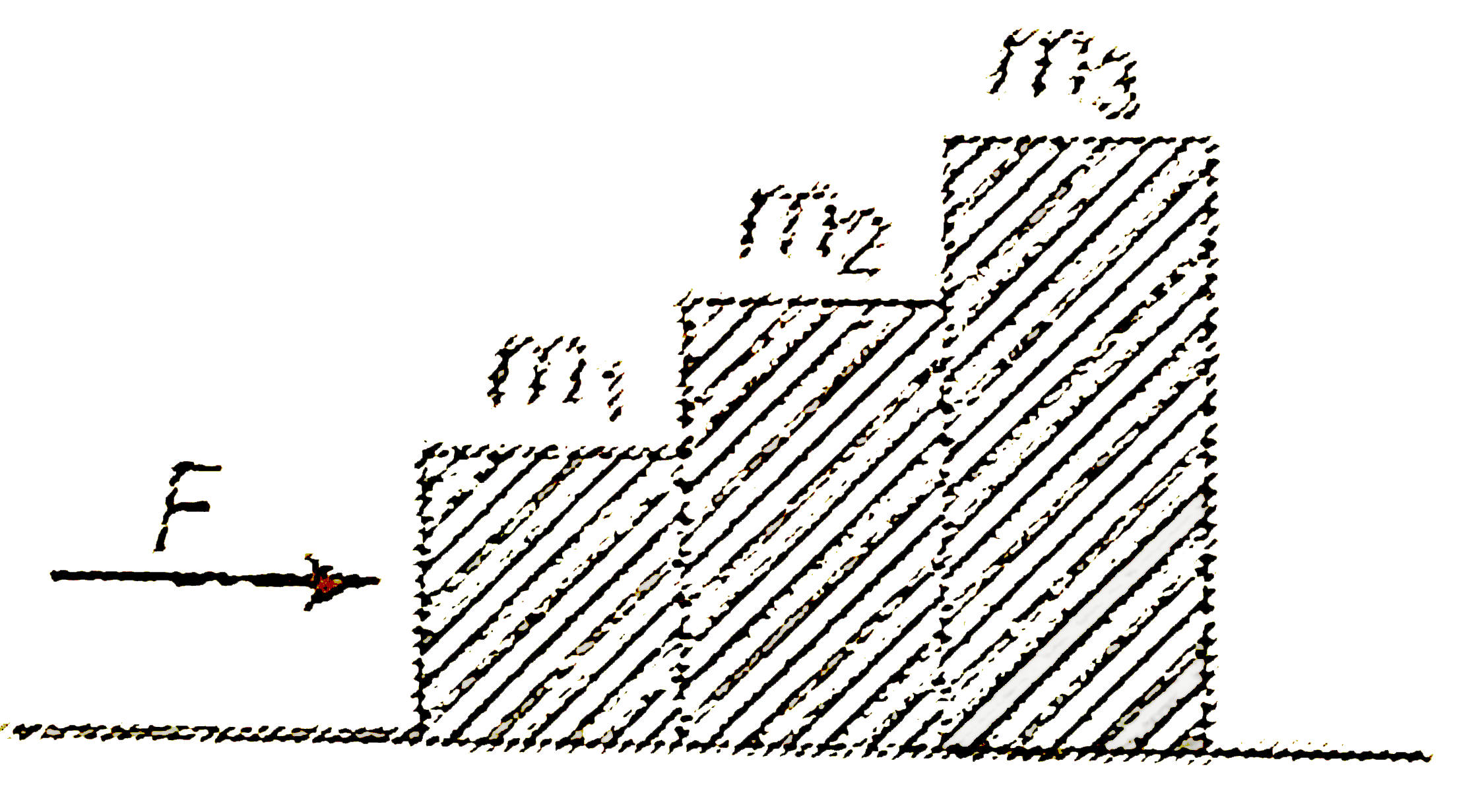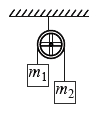Two blocks m1=1kg, m2=2kg are placed one upon the other. m1 is kept on m2. The force of static friction between m1 and m2 is 0.2 and between m2 and the horizontal surface and the floor is 0.28. Calculate the maximum force that can be applied on m2 so that m1 and m2 does not get separated.(g=10ms−2)Solution in Kannada
(i)R=(m2+m1)g
f2=μ2(m2+m1)g=0.28(2+1)9.8=8.232N
f1=μ1m1g=0.2×1×9.8=1.96N
F=(m1+m2)a+μ2(m1+m2)g
F=(1+2)a+8.232
but f1=m1a
∴a=1.96/1=1.96Nkg−1
∴F=3×1.96+8.232=14.112N
F=m1a=1.96N
If f>1.96N, then m1 slip over m2

Topper's Solved these Questions
- LAWS OF MOTIONBook:SUBHASH PUBLICATIONChapter:LAWS OF MOTIONExercise:Five mark question
Explore 4 Videos
- KINETIC THEORYBook:SUBHASH PUBLICATIONChapter:KINETIC THEORYExercise:NUMERICALS WITH SOLUTIONS
Explore 19 Videos
- MECHANICAL PROPERTIES OF FLUIDSBook:SUBHASH PUBLICATIONChapter:MECHANICAL PROPERTIES OF FLUIDSExercise:NUMERICALS WITH SOLUTIONS
Explore 33 Videos
Similar Questions
Derive →F=m→a where the symbols have their usual meanings.
View SolutionIf atomic mass of Argon = 39.9 μ, molecular mass of chlorine = 70.9μ then find the ratio of r.m.s speed of argon atom and chlorine gas molecule.
View SolutionA steel ball of radius 0.5×10−2m is dropped in a long jar containing olive oil of coefficient of viscosity 84×10−3Nsm−2 and density 920kgm−3. If the density of the solid ball is 7.8×103kgm−3 then calculate the terminal velocity attained by the steel ball.
View SolutionTwo blocks of mass m_(1) = 6 kg and m_(2) = 3kg are as shown in the diagram. Coefficient of friction between m_(1) and m_(2) and between m_(1) and m_(2) and between m_(1) and the surface is 0.5 and 0.4 , respectively . The maximum horizontal force that can be applied to the mass m_(1) so that they move without separation is
View SolutionTwo blocks of masses m1 and m2 kept touching each other on an inclined plane of inclination a with the horizontal. Show that (i) theforce of interaction between the blocks is (μ1−μ2)m1m2gcosα(m1+m2) and (ii) the minimum value of α at which the blocks just start sliding is a=tan−1.μ1m1+μ2m2m1+m2 . Where μ1 and μ2 are the coefficients of friction between the block m1 and the inclined plane and between the block m2 and the inclinedplane respectively.
View SolutionThree blocks of masses m1=1kg,m2=2kg and m3=3kg are placed in contact on a horizontal frictionaless plane as shown in figure. A force of 12 N is applied on m1. Acceleration of the system is

View SolutionTwo blocks of mass m1 and m2(m2>m1) are placed in contact with each other on an inclined plane as shown in figure . The coefficient of friction between m1 and surface is μ1 and between m2 and surface is μ2.



View SolutionWhen force F applied on m_(1) and there is no friction between m_(1) and surface and the coefficient of friction between m_(1)and m_(2) is mu. What should be the minimum value of F so that there is on relative motion between m_(1) and m_(2)
View SolutionWhen force F applied on m_(2) and there is no friction between m_(1) and surface and the coefficient of friction between m_(1) and m_(2) is mu… What should be the minimum value of F so that there is no relative motion between m_(1) and m_(2)
View Solutionसूत्र (m1x2+m2x1m1+m2,m1y2+m2y1m1+m2) क्या कहलाता है ?
View SolutionTwo bodies of masses m_(1) and m_(2) are separated by certain distance. If vecF_(12) is the force on m_(1) due to m_(2) and vecF_(21) is the force on m_(2) due to m_(1) , then
View SolutionTwo masses m1 and m2(m2>m1) are hanging vertically over frictionless pulley. The acceleration of the two masses is :

View SolutionConsider the case of two bodies of masses m_(1) and m_(2) which are connected by light inextensible string passing over a light smooth pulley as shown in the figure. The expression for acceleration of the system and tension of the string are expressed below under different situations: (i) when m_(1) gt m_(2) . In this case a=((m_(1)-m_(2))/(m_(1)+m_(2)))g and T=((2m_(1)m_(2))/(m_(1)+m_(2)))g (ii) when m_(2) gt m_(1) . In this case a=((m_(2)-m_(1))/(m_(1)+m_(2)))g and T=((2m_(1)m_(2))/(m_(1)+m_(2)))g (iii) When m_(1)=m_(2)=m . In this case a = 0, T = mg If m_(1)=10kg, m_(2)=6kg and g =10m//s^(2) then what is the acceleration of masses?
View SolutionTwo bodies of masses m1 and m2 are separated by certain distance. If →F12 is the force on m1 due to m2 and →F21 is the force on m2 due to m1, then
View SolutionTwo bodies of masses m1 and m2 are separated by certain distance. If →F12 is the force on m1 due to m2 and →F21 is the force on m2 due to m1, then
View Solution

